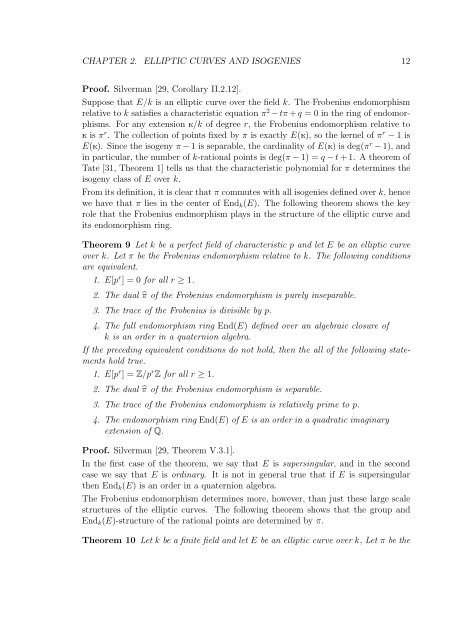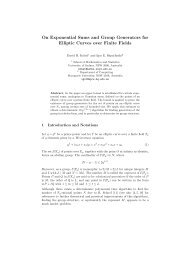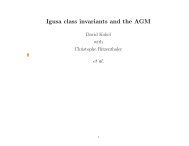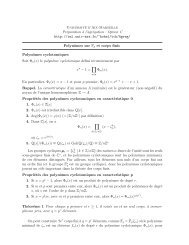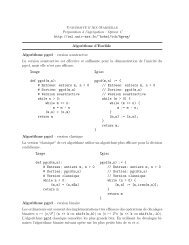Endomorphism rings of elliptic curves over finite fields by David Kohel
Endomorphism rings of elliptic curves over finite fields by David Kohel
Endomorphism rings of elliptic curves over finite fields by David Kohel
You also want an ePaper? Increase the reach of your titles
YUMPU automatically turns print PDFs into web optimized ePapers that Google loves.
CHAPTER 2. ELLIPTIC CURVES AND ISOGENIES 12Pro<strong>of</strong>. Silverman [29, Corollary II.2.12].Suppose that E/k is an <strong>elliptic</strong> curve <strong>over</strong> the field k. The Frobenius endomorphismrelative to k satisfies a characteristic equation π 2 −tπ +q = 0 in the ring <strong>of</strong> endomorphisms.For any extension k/k <strong>of</strong> degree r, the Frobenius endomorphism relative tok is π r . The collection <strong>of</strong> points fixed <strong>by</strong> π is exactly E(k), so the kernel <strong>of</strong> π r − 1 isE(k). Since the isogeny π −1 is separable, the cardinality <strong>of</strong> E(k) is deg(π r −1), andin particular, the number <strong>of</strong> k-rational points is deg(π − 1) = q −t+1. A theorem <strong>of</strong>Tate [31, Theorem 1] tells us that the characteristic polynomial for π determines theisogeny class <strong>of</strong> E <strong>over</strong> k.From its definition, it is clear that π commutes with all isogenies defined <strong>over</strong> k, hencewe have that π lies in the center <strong>of</strong> End k (E). The following theorem shows the keyrole that the Frobenius endmorphism plays in the structure <strong>of</strong> the <strong>elliptic</strong> curve andits endomorphism ring.Theorem 9 Let k be a perfect field <strong>of</strong> characteristic p and let E be an <strong>elliptic</strong> curve<strong>over</strong> k. Let π be the Frobenius endomorphism relative to k. The following conditionsare equivalent.1. E[p r ] = 0 for all r ≥ 1.2. The dual ̂π <strong>of</strong> the Frobenius endomorphism is purely inseparable.3. The trace <strong>of</strong> the Frobenius is divisible <strong>by</strong> p.4. The full endomorphism ring End(E) defined <strong>over</strong> an algebraic closure <strong>of</strong>k is an order in a quaternion algebra.If the preceding equivalent conditions do not hold, then the all <strong>of</strong> the following statementshold true.1. E[p r ] = Z/p r Z for all r ≥ 1.2. The dual ̂π <strong>of</strong> the Frobenius endomorphism is separable.3. The trace <strong>of</strong> the Frobenius endomorphism is relatively prime to p.4. The endomorphism ring End(E) <strong>of</strong> E is an order in a quadratic imaginaryextension <strong>of</strong> Q.Pro<strong>of</strong>. Silverman [29, Theorem V.3.1].In the first case <strong>of</strong> the theorem, we say that E is supersingular, and in the secondcase we say that E is ordinary. It is not in general true that if E is supersingularthen End k (E) is an order in a quaternion algebra.The Frobenius endomorphism determines more, however, than just these large scalestructures <strong>of</strong> the <strong>elliptic</strong> <strong>curves</strong>. The following theorem shows that the group andEnd k (E)-structure <strong>of</strong> the rational points are determined <strong>by</strong> π.Theorem 10 Let k be a <strong>finite</strong> field and let E be an <strong>elliptic</strong> curve <strong>over</strong> k, Let π be the


